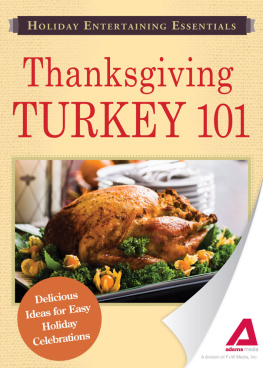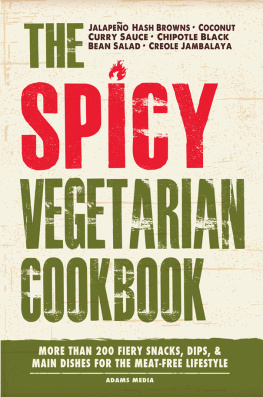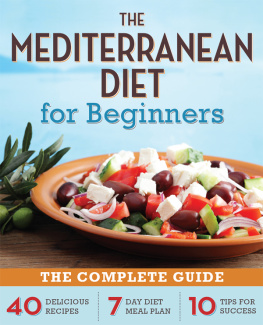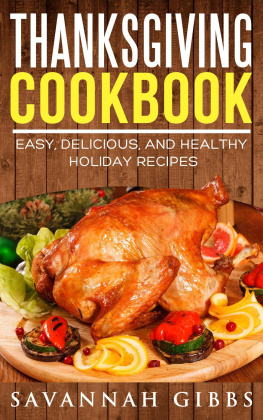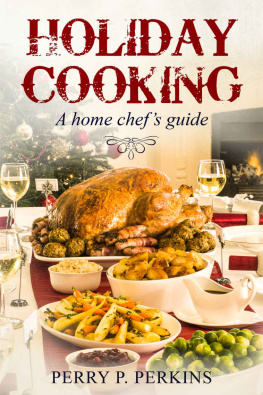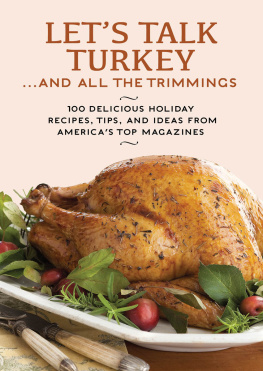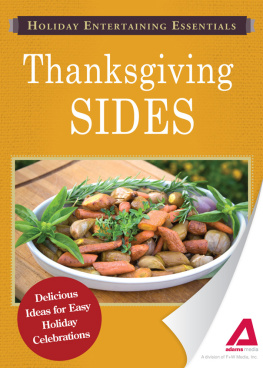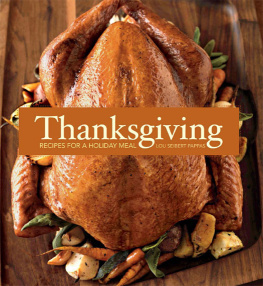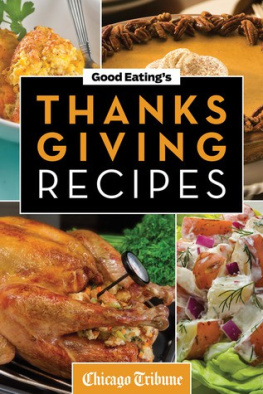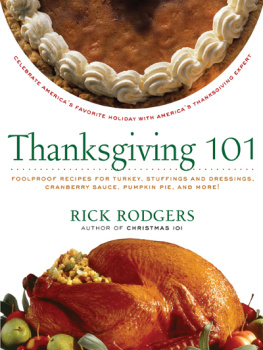
Holiday Entertaining Essentials:
Thanksgiving Turkey 101
Tasty, fresh, and easy to make!
Adams Media, an imprint of Simon & Schuster, Inc.

Avon, Massachusetts
Contents
Introduction
Ordinarily, people roast turkey once a year, if at all. Without the right information, the process can often feel overwhelming. Yet, with a little bit of knowledge and the right recipe, you can feel more comfortable about hosting the big holiday dinner.
Here youll find the basics of buying and storing a turkey, an introduction to a few different cooking methods, and a little about the science behind cooking a turkey all of which add up to simple techniques for turning out a juicy, crowd-pleasing bird.
From the novice holiday host to the poultry aficionado, youll find all you need for the big day and beyond. Included are recipes for roasting, grilling, smoking, and even deep-frying a turkey. And dont forget the leftovers! Weve collected twenty recipes for making the most out of the remains of the big day from traditional soup and casseroles to refreshing, original ideas, like Thai Turkey Curry or Shredded Barbecued Turkey Pizza.
Follow these recipes to the letter or use them as a springboard for your newfound knowledge, substituting your favorite flavorings and spices to create your own holiday menu. Whatever you choose, the results are sure to be consistently delicious!
Happy Thanksgiving!
Part I:
Tips for Buying and Cooking Turkey
How to Buy Your Bird
You might be tempted to gloss over the information on buying and storing your turkey in favor of getting straight to the recipes but dont skip ahead just yet! Unless you know what kind of turkey youre going to be buying, you cant know the best cooking method. In addition, you also need to learn how to properly gauge the size that youll need, depending on the number of guests and the amount of leftovers the best part that you want for delicious soups, casseroles, and pizza. So before you crank up the oven and roast the bird, lets take a look at how to go about properly selecting and storing for the big day!
What Kind of Turkey Should You Buy?
Twenty years ago, youd be lucky to choose between a handful of frozen turkeys, but today there are more varieties, including, free-range, organic, heritage, natural, and other specialties, than are possible to keep track of. So what do the labels really mean? Lets take a look at some of the most common examples to:
- Organic : A turkey with an organic label must have been raised without antibiotics or animal byproducts in their diet.
- Kosher : A Kosher bird is salted under the skin, which acts the same way as a brine would on a traditional turkey. For this reason, you should not brine a Kosher turkey, or you risk an inedibly salty bird!
- Natural : Natural on the label means a turkey that has no added colors or preservatives.
- Free-range : In the United States, free-range only indicates that the bird has been allowed some access to the outdoors. The amount of space is not mandated.
- Heritage : Heritage turkeys generally come from small farms, are free-range, and often are smaller with a gamier quality than the turkeys that are produced by larger companies.
- Fresh/Refrigerated : A fresh turkey has never been frozen. If you choose a refrigerated turkey of any variety, you should plan on cooking it within a day or two.
- Self-Basting : Many commercial varieties of turkey are self-basting. This indicates that some type of seasoned liquid (usually stock or oil) has been added to the turkey to flavor it as it cooks A pre-brined or self-basting turkey should not be brined any further.
The variety of bird you choose depends on your budget, how much work youre willing to do, and whether you or your guests have any dietary preferences.
How Much Do I Need?
After selecting the type of turkey, the next step is to determine how big of a bird youll need to happily serve everyone at your table. After all, you dont want to start a fight over the last drumstick! The rule of thumb for sizing up a Thanksgiving turkey is to allow approximately one pound of bird for each person youll be serving . Remember that the bigger the turkey, the more difficult it can be to roast it through without overcooking the outside. So, if you think youre going to need a turkey thats bigger than 18 pounds, many chefs recommend buying two smaller birds instead. The cooking process will be significantly easier. Plus, having two smaller turkeys can allow you to experiment with different flavors and seasonings.
Storing, Defrosting, and Food Safety
If you selected a fresh bird, store it in the coldest part of your refrigerator and plan on cooking it within two days of purchase. If you are planning to brine your fresh turkey, start the process immediately upon purchase.
But what if you buy frozen? Many people are baffled by the timelines associated with thawing and brining the bird, and you dont want to find yourself desperately trying to defrost a rock-hard piece of poultry three hours before your guests arrive! To avoid this fate, youll want to pick up your frozen turkey about a week in advance so that it has ample time to thaw completely before the big day. As Thanksgiving approaches, move the turkey to the bottom shelf of the refrigerator and defrost it using the five-pound rule: for every five pounds, allot one full day to thawing in the refrigerator. For instance, a 15-pound turkey should be allowed to defrost for at least three days. If you will be brining the bird, make sure it is completely thawed a couple of days in advance.
Although defrosting in the refrigerator is strongly recommended, turkey can also be thawed in a sink filled with cold water. This method is faster (approximately 30 minutes per pound) but its more work for you. The turkey, in its wrapping, should be submerged as fully as possible, and the water needs to be changed every 30 minutes for safety. Youll be losing the use of your sink for the better part of a day, and youll need to monitor the process to make sure that your water is cooler than 40 at all times.
The Basics of Brining
Formerly a way of preserving food, brining has now become a go-to technique for keeping otherwise dry cuts of meat and poultry moist during cooking. The salt in the brine acts on the proteins in the turkey, allowing the poultry to absorb some of the liquid. Your turkey starts out moister and loses far less water during the cooking process. Best of all, brining is mostly foolproof, and all of the work is front-loaded at the beginning of the process.
The Preparation
Typically, brining a turkey takes an hour per pound. For a larger bird, this can easily mean a full 24 hours, so make sure to plan accordingly. To figure out how much brining liquid youll need, place the turkey in your chosen brining container either a brining bag or a large food safe container and cover it fully with water. Remove the turkey and measure the amount of water left in the container.
For each gallon of water, youll need cup of kosher salt (if you use plain table salt, only use cup) and cup of sugar to make the brining mixture. Pour the required amount of cold water into a large saucepan, followed by the salt and the sugar. Heat the mixture, stirring occasionally, until the salt and sugar have dissolved fully into the liquid. Dont let the water boil, because the evaporation that takes place can begin to throw off the ratio in your brine.

